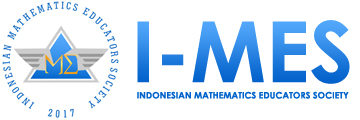Pengembangan Media E-Comath untuk Meningkatkan Kemampuan Komunikasi Matematis Peserta Didik Kelas V dalam Materi Skala pada Denah
DOI:
https://doi.org/10.35706/sjme.v8i2.10788Abstract
Comics are a tool that can be used as a media to improve communication skills through the various graphic illustrations conined in them. In the realm of education, especially in mathematics lessons, comics can be used as a learning media that can improve student mathematical communication skills. In this research, researchers developed digital comic media or E-Comath (Electronic Comic Mathematics) in scale material on a floor plans in class V students at SD Negeri Sindang III through the ADDIE (Analysis, Design, Development, Implementation, Evaluation) development model. In this research, the instruments used were interviews, media and material validation sheets, tests in the form of written questions, and student responsee questionnaires. The validation results show that the E-Comath is valid and suitable for use with an average media assessment percentage of 95,8% and an average material assessment percentage of 98,7% in the very good category. E-Comath media can also increase mathematical communication skills of 0,46 which is calculated using the N-Gain formula, and is included in the moderate improvement category, so it is effective to use. Apart from that, E-Comath media received a positive response from students to be used as a learning media.
Downloads
References
Armiati. (2009). Komunikasi Matematis dan Kecerdasan Emosional. Prosiding Seminar Nasional Matematika Dan Pendidikan Matematika, 16, 270–280. Retrieved from http://eprints.uny.ac.id/id/eprint/7030
Cahyadi, R. A. H. (2019). Pengembangan Bahan Ajar Berbasis Addie Model. Halaqa: Islamic Education Journal, 3(1), 35–42. https://doi.org/10.21070/halaqa.v3i1.2124
Faturohman, I., & Afriansyah, E. A. (2020). Peningkatan Kemampuan Berpikir Kreatif Matematis Siswa melalui Creative Problem Solving. Mosharafa: Jurnal Pendidikan Matematika, 9(1), 107–118. https://doi.org/10.31980/mosharafa.v9i1.562
Fayakun, M., & Joko, P. (2015). Efektivitas pembelajaran fisika menggunakan model kontekstual (ctl) dengan metodepredict, observe, explain terhadap kemampuan berpikir tingkat tinggi. Jurnal Pendidikan Fisika Indonesia, 11(1), 49–58. https://doi.org/10.15294/jpfi.v11i1.4003
Hasbi, M., Suri, M., & Kurniawati, S. (2023). Factors affecting the communication of mathematical ability for Junior High School students. Journal of Education Science (JES), 9(1), 7–16.
Kadarisma, G. (2018). Penerapan Pendekatan Open-Ended dalam Meningkatkan Kemampuan Komunikasi SISWA SMP. ANARGYA: Jurnal Ilmiah Pendidikan Matematika, 1(2), 77–81. https://doi.org/10.24176/anargya.v1i2.2570
Martunis, Ikhsan, M., & Rizal, S. (2014). Meningkatkan Kemampuan Pemahaman Dan Komunikasi Matematis Siswa Sekolah Menengah Atas Melalui Model Pembelajaran Generatif. Jurnal Didaktik Matematika, 1(2), 75–84.
Maydiantoro, A. (2019). Model-Model Penelitian Pengembangan (Research and Development). Jurnal Metode Penelitian, (10), 1–8. Retrieved from http://repository.lppm.unila.ac.id/34333/1/Model-Model Penelitian dan Pengembangan.pdf
Nuraeni, S. (2016). Pengaruh Penggunaan Media Pembelajaran Melalui Komik dalam Pembelajaran Matematika Terhadap Kemampuan Komunikasi Matematis Siswa SMP. FKIP UNPAS.
Nurdiana, W. S., Windayana, H., & Yunansah, H. (2016). Pengaruh Komik Edukasi Matematika Terhadap Kemampuan Komunikasi Matematis Siswa Pada Operasi Hitung Bilangan Pecahan. Jurnal PGSD Kampus Cibiru, 4(3).
Permana, Y. (2001). Analisis Tingkat Penguasaan Siswa dalam Menyelesaikan Persoalan Kontekstual pada Pembelajaran Matematika. Universitas Pendidikan Indonesia.
Pribadi, A. B. (2009). Model Desain Sistem Pembelajaran. Jakarta: Dian Rakyat.
Purnomosidi, Wiyanto, Safiroh, dan I. G. (2018). Senang Belajar Matematika SD/MI Kelas V. In Analisis Standar Pelayanan Minimal Pada Instalasi Rawat Jalan di RSUD Kota Semarang (Vol. 3).
Rasyid, M. A. (2020). Kemampuan Komunikasi Matematis Dalam Pembelajaran Matematika. Jurnal Edukasi: Kajian Ilmu Pendidikan, 5(1), 77–86. https://doi.org/10.51836/je.v5i1.116
Santosa, A. P. D. (2022). Pengembangan Media Pembelajaran Komik Digital Interaktif Materi Sudut dalam Meningkatkan Komunikasi Matematis Siswa SD. Universitas Muhammadiyah Malang.
Sari, R. M. (2018). Pengembangan Media Komik Matematika Materi Debit pada Siswa Kelas V Sekolah Dasar. 5(1), 79–90. Retrieved from https://eprints.umm.ac.id/39335/%0Ahttps://eprints.umm.ac.id/39335/1/PENDAHULUAN.pdf
Supriadi, S. (2018). Penggunaan Kartun Matematika dalam Pembelajaran Matematika. Pendidikan Dasar, (oktober), 10.
Syamsurijal, Iwan, S., & Muhammad, Y. M. (2022). Efektivitas Media Elektronik Komik Digital untuk Meningkatkan Prestasi Belajar Mahasiswa. Jurnal Pendidikan Tambusai, 6(3), 10529–10535.
Tyas, N. M. (2016). Analisis Faktor Penyebab Kesulitan Belajar Matematika Kelas IV Sekolah Dasar Negeri Di Kecamatan Ungaran Barat Kabupaten Semarang. In Digital Repository IAIN Purwokerto.
Umar, W. (2012). MEMBANGUN KEMAMPUAN KOMUNIKASI MATEMATIS DALAM PEMBELAJARAN MATEMATIKA. Infinity Journal. https://doi.org/https://doi.org/10.22460/infinity.v1i1.2
Vidya, N. A. (2023). PENGARUH PENGGUNAAN MEDIA KOMIK MATEMATIKA TERHADAP KEMAMPUAN KOMUNIKASI MATEMATIS SISWA (Studi pada Siswa Kelas VII SMP Negeri 26 Bandar Lampung Semester Genap Tahun Pelajaran 2022/2023).
Downloads
Published
How to Cite
Issue
Section
License

This work is licensed under a Creative Commons Attribution-ShareAlike 4.0 International License.
Authors who publish with this journal agree to the following terms:
- Authors retain copyright and grant the journal right of first publication with the work simultaneously licensed under a Creative Commons Attribution License that allows others to share the work with an acknowledgment of the work's authorship and initial publication in this journal.
- Authors are able to enter into separate, additional contractual arrangements for the non-exclusive distribution of the journal's published version of the work (e.g., post it to an institutional repository or publish it in a book), with an acknowledgment of its initial publication in this journal.
- Authors are permitted and encouraged to post their work online (e.g., in institutional repositories or on their website) prior to and during the submission process, as it can lead to productive exchanges, as well as earlier and greater citation of published work (See The Effect of Open Access).










